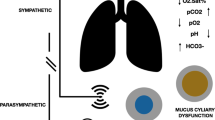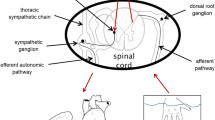Abstract
Objective
There is limited information on the relationship between the level and completeness of the spinal cord injury (SCI) lesion and the degree of autonomic dysfunction. We aimed to study the impairment of sympathetic function in chronic SCI patients presenting with a motor and sensory complete lesion above T6.
Method
26 consecutive traumatic SCI patients were enrolled (14 tetraplegics and 12 paraplegics). They took a battery of tests that included pressor stimuli above (mental arithmetic, hand cold pressor test, sympathetic skin responses (SSR)) and below the lesion (foot cold pressor test, abdominal electrical stimulation), and Valsalva maneuver.
Results
All patients showed abolished plantar SSR, while a significant rise in systolic blood pressure in at least one of the pressor tests below the lesion was seen in all but one paraplegic patient. Palmar SSR and blood pressure overshoot at the end of the Valsalva maneuver were abolished in all tetraplegics, whereas at least one of those responses was seen in each paraplegic. Hand cold pressor test and mental arithmetic induced cardiovascular changes in most patients.
Conclusion
A complete loss of supraspinal control was observed in all, with a reflex isolated spinal cord in all but one patient. We confirm that in most SCI subjects there is concordance between the impairment of sympathetic function and somatic impairment. To assess autonomic dysfunction, a battery of tests should include SSR, abdominal electrical stimulation and Valsalva maneuver, as they combine pressor stimuli above and below the lesion and assess both cholinergic and sudomotor pathways.

Similar content being viewed by others
References
Mathias CJ, Frankel HL (2002) Autonomic disturbances in spinal cord lesions. In: Bannister R, Mathias CJ (eds) Autonomic failure, 4th edn. Oxford University Press, Oxford, pp 494–513
Alexander MS, Biering-Sorensen F, Bodner D, Brackett NL, Cardenas D, Charlifue S et al (2009) International standards to document remaining autonomic function after spinal cord injury. Spinal Cord 47(1):36–43
Maynard FM Jr, Bracken MB, Creasey G, Ditunno JF Jr, Donovan WH, Ducker TB et al (1997) International standards for neurological and functional classification of spinal cord injury. American spinal injury association. Spinal Cord 35(5):266–274
Previnaire JG, Mathias CJ, El Masri W, Soler JM, Leclercq V, Denys P (2010) The isolated sympathetic spinal cord: cardiovascular and sudomotor assessment in spinal cord injury patients: a literature survey. Ann Phys Rehabil Med 53(8):520–532
Cariga P, Catley M, Mathias CJ, Savic G, Frankel HL, Ellaway PH (2002) Organisation of the sympathetic skin response in spinal cord injury. J Neurol Neurosurg Psychiatry 72(3):356–360
Curt A, Nitsche B, Rodic B, Schurch B, Dietz V (1997) Assessment of autonomic dysreflexia in patients with spinal cord injury. J Neurol Neurosurg Psychiatry 62(5):473–477
Curt A, Weinhardt C, Dietz V (1996) Significance of sympathetic skin response in the assessment of autonomic failure in patients with spinal cord injury. J Auton Nerv Syst 61(2):175–180
Reitz A, Schmid DM, Curt A, Knapp PA, Schurch B (2002) Sympathetic sudomotor skin activity in human after complete spinal cord injury. Auton Neurosci 102(1–2):78–84
Kooijman M, Rongen GA, Smits P, Hopman MT (2003) Preserved alpha-adrenergic tone in the leg vascular bed of spinal cord-injured individuals. Circulation 108(19):2361–2367
Brown R, Engel S, Wallin BG, Elam M, Macefield V (2007) Assessing the integrity of sympathetic pathways in spinal cord injury. Auton Neurosci 134(1–2):61–68
Gilliatt RW, Guttmann L, Whitteridge D (1948) Inspiratory vaso-constriction in patients after spinal injuries. J Physiol 107(1):67–75
Claydon VE, Krassioukov AV (2006) Orthostatic hypotension and autonomic pathways after spinal cord injury. J Neurotrauma 23(12):1713–1725
Previnaire JG, Soler JM, El Masri W, Denys P (2009) Assessment of the sympathetic level of lesion in patients with spinal cord injury. Spinal Cord 47:122–127
Karlsson AK (1999) Autonomic dysreflexia. Spinal Cord 37(6):383–391
Teasell RW, Arnold JM, Krassioukov A, Delaney GA (2000) Cardiovascular consequences of loss of supraspinal control of the sympathetic nervous system after spinal cord injury. Arch Phys Med Rehabil 81(4):506–516
Catz A, Bluvshtein V, Korczyn AD, Pinhas I, Gelernter I, Nissel T et al (2007) Modified cold pressor test by cold application to the foot after spinal cord injury: suggestion of hemodynamic control by the spinal cord. Am J Phys Med Rehabil 86(11):875–882
Krassioukov AV, Karlsson AK, Wecht JM, Wuermser LA, Mathias CJ, Marino RJ (2007) Assessment of autonomic dysfunction following spinal cord injury: rationale for additions to International Standards for Neurological Assessment. J Rehabil Res Dev 44(1):103–112
Carbonneil C (2007) Evaluation cardiovasculaire du systeme nerveux autonome lors de tests dynamiques. Hautes Autorité en Santé. Service Evaluation des actes professionnels. Last accessed 14 April 2011 http://www.has-sante.fr/portail/jcms/c_558365/evaluation-cardiovasculaire-du-systeme-nerveux-autonome-lors-de-5-tests-dynamiques
Houtman S, Oeseburg B, Hopman MT (1999) Non-invasive assessment of autonomic nervous system integrity in able-bodied and spinal cord-injured individuals. Clin Auton Res 9(3):115–122
Nagarajarao HS, Kumar BN, Watt JW, Wiredu E, Bhamidimarri K (2006) Bedside assessment of sympathetic skin response after spinal cord injury: a brief report comparing inspiratory gasp and visual stimulus. Spinal Cord 44(4):217–221
Low P, Slatten D (2008) Laboratory evaluation of autonomic failure. In: Low P, Benarroch E (eds) Clinical autonomic disorders, 3rd edn. Lippincott Williams & Wilkins, Baltimore, pp 130–160
Karlsson AK, Friberg P, Lonnroth P, Sullivan L, Elam M (1998) Regional sympathetic function in high spinal cord injury during mental stress and autonomic dysreflexia. Brain 121(Pt 9):1711–1719
Groothuis JT, Hopman MT (2009) Hemodynamic responses to the cold pressor test in spinal cord-injured individuals; control of the splanchnic vascular bed is the key factor. Spinal Cord 47 (1):95 (author reply 96)
Catz A, Bluvshtein V, Pinhas I, Akselrod S, Gelernter I, Nissel T et al (2008) Cold pressor test in tetraplegia and paraplegia suggests an independent role of the thoracic spinal cord in the hemodynamic responses to cold. Spinal Cord 46(1):33–38
Lehmann KG, Shandling AH, Yusi AU, Froelicher VF (1989) Altered ventricular repolarization in central sympathetic dysfunction associated with spinal cord injury. Am J Cardiol 63(20):1498–1504
Pollock LJ, Boshes B, Chor H, Finkelman I, Arieff AJ, Brown M (1951) Defects in regulatory mechanisms of autonomic function in injuries to spinal cord. J Neurophysiol 14(2):85–93
Brown R, Macefield VG (2008) Assessing the capacity of the sympathetic nervous system to respond to a cardiovascular challenge in human spinal cord injury. Spinal Cord 46(10):666–672
Nicotra A, Catley M, Ellaway PH, Mathias CJ (2005) The ability of physiological stimuli to generate the sympathetic skin response in human chronic spinal cord injury. Restor Neurol Neurosci 23(5–6):331–339
Nathan PW, Smith MC (1987) The location of descending fibres to sympathetic preganglionic vasomotor and sudomotor neurons in man. J Neurol Neurosurg Psychiatry 50(10):1253–1262
Claydon VE, Elliott SL, Sheel AW, Krassioukov A (2006) Cardiovascular responses to vibrostimulation for sperm retrieval in men with spinal cord injury. J Spinal Cord Med 29(3):207–216
Mathias CJ, Bannister R (2002) Investigation of autonomic disorders. In: Bannister R, Mathias CJ (eds) Autonomic failure, 4th edn. Oxford University Press, Oxford, pp 169–195
Acknowledgments
The authors are grateful to Isabelle Vaugier (CIC-IT Garches) for statistical assistance.
Conflict of interest
The authors declare no conflict of interest.
Author information
Authors and Affiliations
Corresponding author
Additional information
We state (1) that the manuscript is not being considered for publication elsewhere and will not be submitted elsewhere while under consideration for Clinical Autonomic Research, and that (2) the study was conducted in accordance with the Declaration of Helsinki.
Rights and permissions
About this article
Cite this article
Previnaire, J.G., Soler, J.M., Leclercq, V. et al. Severity of autonomic dysfunction in patients with complete spinal cord injury. Clin Auton Res 22, 9–15 (2012). https://doi.org/10.1007/s10286-011-0132-8
Received:
Accepted:
Published:
Issue Date:
DOI: https://doi.org/10.1007/s10286-011-0132-8




